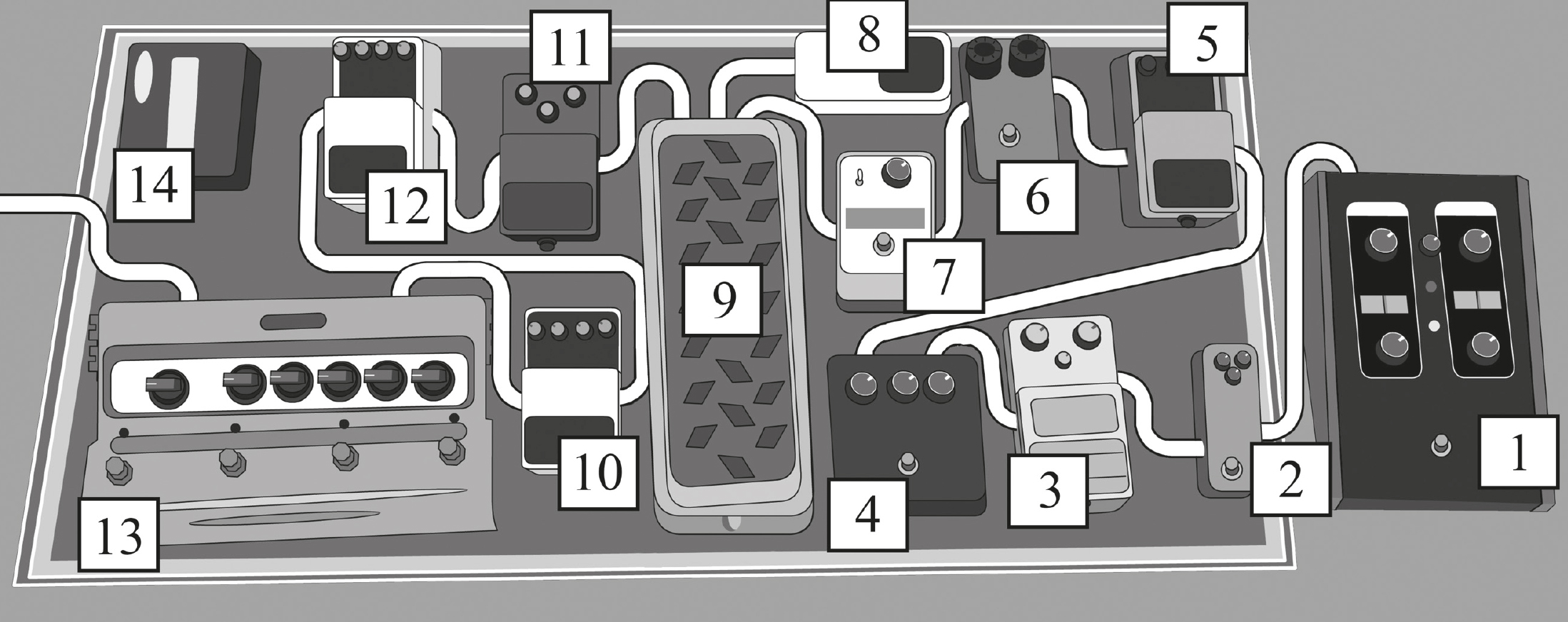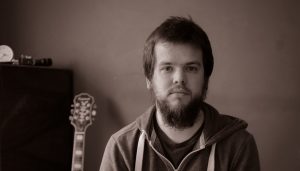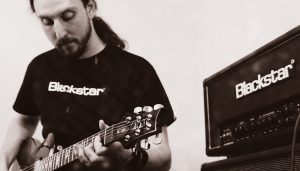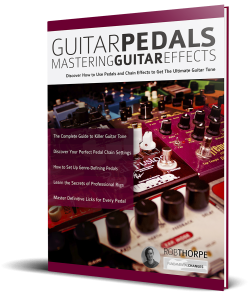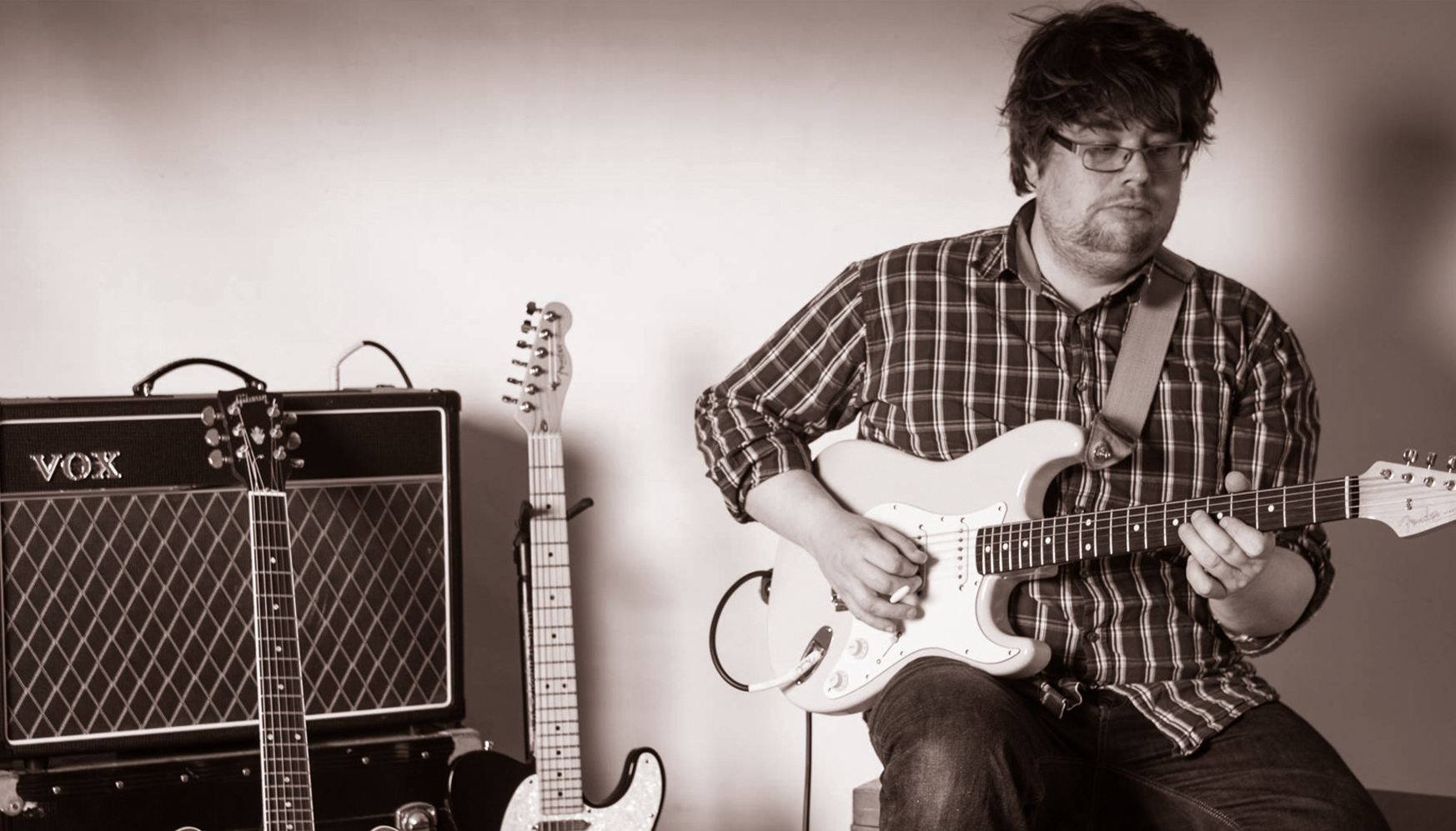
NIK SVARC
Next up is Leeds-based guitarist and educator Nik Svarc. Nik regularly performs around the country with hisjazz-rock trio as well as with a host of noted jazz musicians.
www.niksvarc.com / @niksvarc
Were there any particular guitarists or songs that inspired your tone and use of effects?
Later on, it was John Scofield for mixing blues and jazz, as well as his use of modulation. Wayne Krantz, for his use of the wah and MoogerFooger. Bill Frisell too – the amount of variety in his playing – jazz, country, Americana, rock – is amazing. Holdsworth was another big influence. Secrets was an amazing album. I never got into the midi-guitar thing live, but I use one for composing at home. Wayne Krantz uses effects in interesting ways, like putting the wah in front of the MoogerFooger (ring modulator) so the wah shifts the affected frequency range. He also uses an old DD-3 just because it sounds a bit crummy compared to a modern studio 24-bit delay like a Timeline. So, I learnt a lot bylistening and watching him play and being that geek who goes up to the stage to look at the pedalboard.
How did you arrive at your current setup?
I don’t just play crazy jazz, I have to play lots of different types of gigs. It took a long time to build that board up. Basically, I wanted a workable board I can use for any gig. So, I just add things around that for different gigs, rather than having two boards. I’d use most of it on a function gig, maybe apart from the Freeze pedal.
I just have the standard things. Three different types of distortion: The Wampler Tumnus, an old modded Ibanez 808 Tubescreamer and a Pro Co Rat. The Tumnus sounds amazing when stacked with other distortions, but sometimes that’s too noisy at stage volumes. Then there’s an old Rat. I’m obsessed with Rat pedals, I’ve got about four, but that’s a mid-80s one and seems to sound warmest. The chorus is an old Boss CE-2. There’s nothing on the board that’s too expensive or difficult to replace.
The MF-102 ring modulator makes all those Dalek sounds, but it’s an interesting pedal because you can also use it as a tremolo. It makes a really nice tremolo. You hear it in Krantz’s music. There’s a whole range from Moog that look the same, but do different things. There’s a very nice analogue delay pedal but it’s reallyexpensive.
I used to have a digital ring modulator; I didn’t like it at all. Some effects I don’t like to be digital, while others can sound cool. I really don’t like digital chorus; old analogue chorus just sounds so much different. I use chorus in a different way. There’s a trick I stole off Schofield: turn every setting up to create a Lesley [rotary speaker] sound, and it only works with an analogue chorus. If you do it with a digital chorus it just soundsterrible. Digital delays are great though, because you can tap-tempo them. Analogue delays are not always so precise.
Amp-wise, I use a Fender Twin, Mesa Boogie Lonestar or Vox AC-15. There’s quite a wide range of sounds available from those amps. I occasionally use the drive channels, but usually just run them on clean or get the AC-15 to just break up.
I see you’ve got three different delays. How do they work together – or are they just different settings?
I love the Line6 DL-4. I know it’s old, but when it came out it was the only thing that could do that many things. Now you can buy a Timeline or whatever, and they’d sound better, but I still love it, mainly for the loop sampler. I use that quite a lot for creating soundscapes and so forth.
The Boss DD-6 has a function called Warp, which captures a note or chord in a really bizarre, stuttering kind of way. It’s similar to the Freeze, and I used it before the Freeze came out. I only use that pedal for the warp function. Marc Ducret [avantgarde improvising/jazz guitarist] uses that sound, also Chris Sharkey from TrioVD and metal bands like Dillinger Escape Plan.
The DD-3 just has a classic delay that sounds great to my ears. I’ve always liked it. I use that for quite long delays, a lot of volume swells and creating ambience. So, each one just has its different vibe really.
How would you practise integrating effects into your general playing vocabulary?
Use effects as part of your practice, rather than seeing them as a separate thing to your instrument. See it all as one thing for creating a sound. I think a lot of people don’t practise with their effects. I know a lot of my students don’t. They turn up to a gig and expect it to work, but it doesn’t work like that – you’ve got to figureout what settings you want to use. I like to have everything sorted out before I even enter a rehearsal.
NIK’S RIG
Click rig image below to enlarge
|
1 MoogerFooger Ring Modulator |
8 Volume Pedal |
|
2 Wampler Tumnus |
9 TC Electronic Polytune |
|
3 Ibanez Tubescreamer |
10 Boss Octave OC-2 |
|
4 Pro Co. Rat |
11 Boss DD-3 Digital Delay |
|
5 Boss CE-3 Chorus |
12 Boss DD-6 Digital Delay |
|
6 MXR Dyna Comp |
13 Line 6 DL-4 Delay Modeller |
|
7 Electro Harmonix Freeze |
14 T-Rex Fuel Tank (power supply) |

